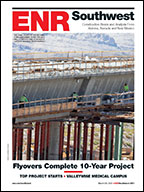A type of roadside guardrail that has sparked controversy about its safety has passed a set of crash tests, and states can continue to seek federal reimbursements for the cost of purchasing it, the Federal Highway Administration says.
The test results, which FHWA officials announced on March 13, aren’t the last word, however, on the ET-Plus guardrail end caps, made by Dallas-based Trinity Industries Inc. FHWA officials say that they will continue to review additional information about the product, including data on how they have performed in the field.
On Capitol Hill, Sen. Richard Blumenthal (D-Conn.) sharply criticized FHWA for what he terms its “inadequate oversight” of the guardrails and contended it let Trinity “conduct sham tests rife with flaws.”
Blumenthal and five other Senate Democrats on March 3 also asked the Government Accountability Office to study FHWA’s role in ensuring safety of guardrails and other roadside hardware, the process for developing rules governing such equipment and the testing process for the devices.
The ET-Plus controversy heated up last October, when a federal jury in Texas returned a verdict valued at $525 million against Trinity, which, the senators said, was alleged to have altered the guardrail specifications without notifying FHWA.
Since then, 40 states plus the District of Columbia suspended use of the ET-Plus as of Nov. 18, a FHWA spokesman said. He added that the agency has received no further updates from states since November.
Virginia officials on Dec. 11 filed a lawsuit against Trinity, alleging that the company made changes in the guardrail end cap and didn't disclose the changes to FHWA or the state.
The state attorney general's office said that the lawsuit came after a series of accidents "involving serious injury or death in which the modified guardrail end treatments appear to have malfunctioned."
From the results of the latest group of four tests, which took place at the Southwest Research Institute in Texas from Jan. 15 to Jan. 27, “We have concluded that the ET-Plus meets the applicable crash criteria,” FHWA Deputy Administrator Gregory Nadeau told reporters in a March 13 conference call briefing.
Tony Furst, FHWA associate administrator for safety, said that the guardrail at a 31-in. height did not penetrate the vehicle in any of the tests. The guardrail had a 4-in.-wide guide channel.
From Dec. 10, 2014, to Jan. 6, 2015, the research institute ran four other crash tests with the guardrail height set at 27-3/4 in.
In one test, he added, the rail impact caused a “deformation” of the vehicle's exterior of about 6-3/4 in., at about the level of the top of the seat cushion. But that was not enough to give the equipment a failing grade for that test.
Nadeau said that the new test results mean that the ET-Plus “remains eligible for federal funding.” He added that it is up to each state to determine which guardrail products it will use.
State departments of transportation typically incur a cost for a highway project then seek reimbursement from FHWA.
“But we are not done,” Nadeau said, noting that FHWA now will evaluate “real-world” crash test criteria for the guardrail.
Jeffrey Paniati, FHWA executive director, said, “We have not come to the conclusion whether additional testing is required or not.”
That decision will be based on work of joint FHWA-American Association of State Highway and Transportation Officials task force that is reviewing crash test data from a variety of other sources, including state DOTs and responses to a FHWA Federal Register request for information.
Jeff Eller, a Trinity spokesman, said in an interview, “We were pleased by the results that [FHWA] released today as well as their comment that it remains eligible for federal reimbursement.”
He added, “We’ve said all along that when this product is properly installed and maintained, it performs within its design criteria.”




Post a comment to this article
Report Abusive Comment